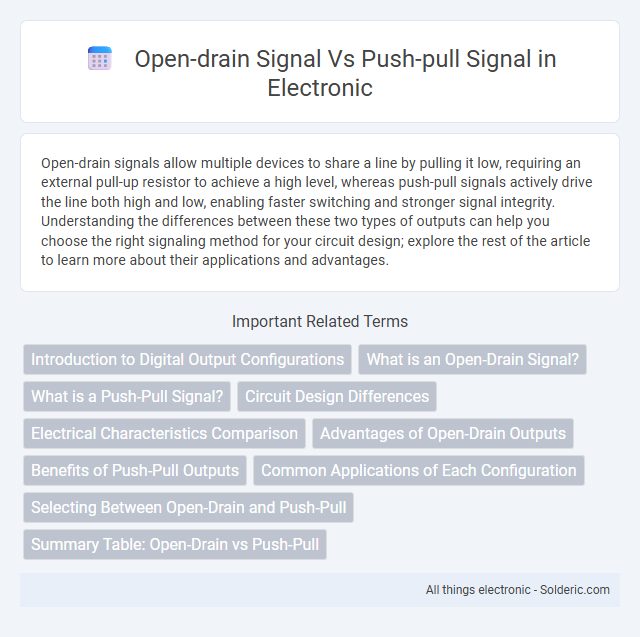Open-drain signals allow multiple devices to share a line by pulling it low, requiring an external pull-up resistor to achieve a high level, whereas push-pull signals actively drive the line both high and low, enabling faster switching and stronger signal integrity. Understanding the differences between these two types of outputs can help you choose the right signaling method for your circuit design; explore the rest of the article to learn more about their applications and advantages.
Comparison Table
| Feature | Open-Drain Signal | Push-Pull Signal |
|---|---|---|
| Output Type | Transistor pulls to ground only | Transistor both pulls to ground and Vcc |
| Voltage Levels | Requires external pull-up resistor for high level | Provides both high and low voltage levels internally |
| Wiring | Wired-AND or wired-OR capable | Not suitable for wired-AND wiring |
| Power Consumption | Lower static power when output low | Higher power due to push-pull stage operation |
| Speed | Slower rise time, depends on pull-up resistor | Faster switching with active drive both ways |
| Noise Immunity | Better noise margin on low state | Good noise margin on both states |
| Applications | I2C bus, interrupt lines, open-collector outputs | General digital output, SPI, UART |
Introduction to Digital Output Configurations
Open-drain and push-pull outputs represent two fundamental digital output configurations used in microcontrollers and integrated circuits. Open-drain outputs can only sink current, requiring an external pull-up resistor to achieve a high logic level, making them ideal for wired-AND logic and bus sharing applications. Push-pull outputs actively drive both high and low states, providing faster switching speeds and stronger drive capability for standard digital signaling.
What is an Open-Drain Signal?
An open-drain signal is a type of digital output commonly used in microcontrollers, where the transistor connects the output pin to ground but cannot drive it high, requiring an external pull-up resistor to achieve a high state. This configuration enables multiple devices to share a single communication line for wired-AND logic, enhancing signal integrity and reducing pin count. Understanding open-drain signals is crucial for designing circuits that support bidirectional communication or require safe multi-device interfacing.
What is a Push-Pull Signal?
A push-pull signal is an output configuration where two transistors alternately drive the output line high or low, providing both sourcing and sinking current capabilities. This arrangement enables faster switching speeds and stronger drive strength compared to open-drain outputs, making push-pull signals ideal for driving digital loads with low output impedance. Push-pull outputs inherently prevent floating states by actively controlling the line voltage in both logic states.
Circuit Design Differences
Open-drain signals use a transistor with the drain terminal as the output stage, requiring an external pull-up resistor to a positive voltage, enabling multiple devices to share a common bus line without conflict. Push-pull signals incorporate both sourcing and sinking transistors in the output stage, actively driving the line high or low, which results in faster switching and stronger signal integrity. Circuit design with open-drain emphasizes simplicity and wired-AND logic, while push-pull designs focus on speed and full voltage rail drive capability.
Electrical Characteristics Comparison
Open-drain signals feature a transistor that can only pull the line low, relying on an external pull-up resistor to achieve a high state, resulting in slower rise times and higher power consumption due to constant current flow through the resistor. Push-pull signals utilize two complementary transistors actively driving the line both high and low, enabling faster switching speeds and lower power consumption with stronger output drive capability. The open-drain configuration excels in wired-AND or multi-drop bus applications, whereas push-pull outputs provide better noise immunity and signal integrity for point-to-point communication.
Advantages of Open-Drain Outputs
Open-drain outputs enable multiple devices to share a single communication line without risk of damage, supporting wired-AND logic and simplifying bus topology. They consume less power when in the high-impedance state, reducing overall system power consumption in low-frequency or idle conditions. These outputs also provide greater flexibility for level shifting between different voltage domains, enhancing compatibility in mixed-voltage environments.
Benefits of Push-Pull Outputs
Push-pull outputs provide faster switching speeds and improved signal integrity by actively driving the output both high and low, reducing noise and voltage drop. This design minimizes power consumption during state transitions and ensures better compatibility with digital circuits requiring precise voltage levels. Your system benefits from enhanced performance and reliability when using push-pull signals compared to open-drain configurations.
Common Applications of Each Configuration
Open-drain signals are commonly used in I2C communication buses, wired-AND logic circuits, and interrupt lines where multiple devices share a single line, allowing devices to pull the line low without driving it high. Push-pull signals are prevalent in applications requiring rapid switching and strong drive capabilities, such as microcontroller GPIO outputs, LED driving, and digital logic circuits for clear high and low voltage levels. Your choice depends on whether shared bus communication or fast, definitive signal transitions are needed.
Selecting Between Open-Drain and Push-Pull
Selecting between open-drain and push-pull signals depends on the application requirements for signal integrity and control. Open-drain outputs are ideal for wired-AND logic configurations and allow multiple devices to share the same line with external pull-up resistors, providing flexibility in signal level and voltage compatibility. Push-pull outputs deliver faster switching speeds and stronger drive capability, suitable for driving loads directly without external components, making them preferable in high-speed digital circuits.
Summary Table: Open-Drain vs Push-Pull
Open-drain signals allow multiple devices to share a line by pulling it low or leaving it floating, requiring an external pull-up resistor for a defined high level, making them ideal for wired-AND logic and bus communication like I2C. Push-pull signals actively drive the line both high and low, offering faster transitions and stronger drive capability but limiting multi-device line sharing. A summary table highlights open-drain's advantages in multi-node interfacing and simplicity against push-pull's speed and output drive strength, providing clear guidance for application-specific signal type selection.
open-drain signal vs push-pull signal Infographic

 solderic.com
solderic.com